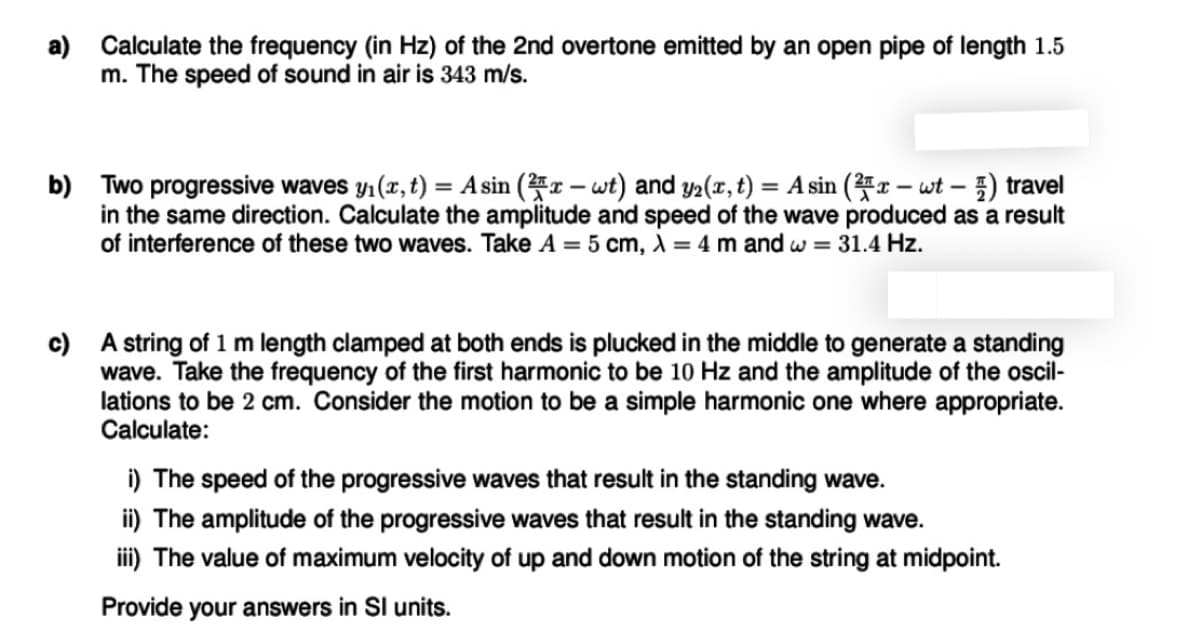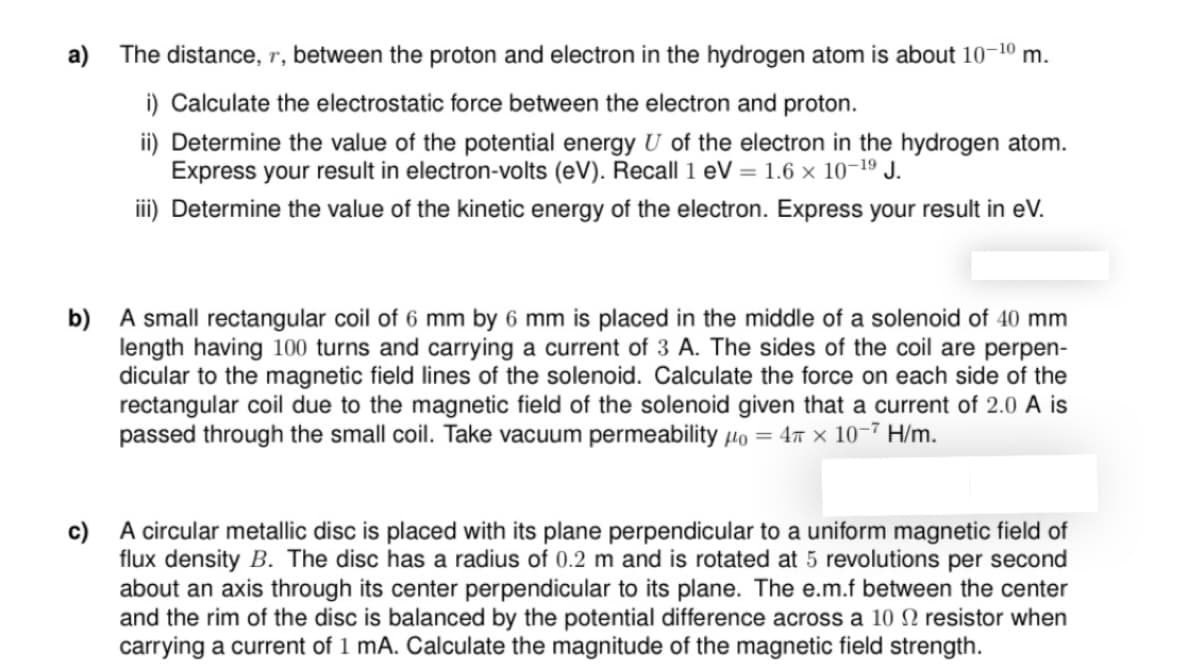Physics for Scientists and Engineers: Foundations and Connections
1st Edition
ISBN:9781133939146
Author:Katz, Debora M.
Publisher:Katz, Debora M.
Chapter18: Superposition And Standing Waves
Section: Chapter Questions
Problem 50PQ
Related questions
Question
Can you answer both of the pages please?

Transcribed Image Text:a) Calculate the frequency (in Hz) of the 2nd overtone emitted by an open pipe of length 1.5
m. The speed of sound in air is 343 m/s.
b) Two progressive waves y1 (x, t) = A sin (r – wt) and y2(x, t) = A sin (x – wt – ) travel
in the same direction. Calculate the amplitude and speed of the wave produced as a result
of interference of these two waves. Take A = 5 cm, ) = 4 m and w = 31.4 Hz.
c) A string of 1 m length clamped at both ends is plucked in the middle to generate a standing
wave. Take the frequency of the first harmonic to be 10 Hz and the amplitude of the oscil-
lations to be 2 cm. Consider the motion to be a simple harmonic one where appropriate.
Calculate:
i) The speed of the progressive waves that result in the standing wave.
ii) The amplitude of the progressive waves that result in the standing wave.
ii) The value of maximum velocity of up and down motion of the string at midpoint.
Provide your answers in SI units.

Transcribed Image Text:a) The distance, r, between the proton and electron in the hydrogen atom is about 10¬10 m.
i) Calculate the electrostatic force between the electron and proton.
ii) Determine the value of the potential energy U of the electron in the hydrogen atom.
Express your result in electron-volts (eV). Recall 1 eV = 1.6 × 10-19 J.
ii) Determine the value of the kinetic energy of the electron. Express your result in eV.
b) A small rectangular coil of 6 mm by 6 mm is placed in the middle of a solenoid of 40 mm
length having 100 turns and carrying a current of 3 A. The sides of the coil are perpen-
dicular to the magnetic field lines of the solenoid. Calculate the force on each side of the
rectangular coil due to the magnetic field of the solenoid given that a current of 2.0 A is
passed through the small coil. Take vacuum permeability µo = 4x × 10-7 H/m.
c) A circular metallic disc is placed with its plane perpendicular to a uniform magnetic field of
flux density B. The disc has a radius of 0.2 m and is rotated at 5 revolutions per second
about an axis through its center perpendicular to its plane. The e.m.f between the center
and the rim of the disc is balanced by the potential difference across a 10 N resistor when
carrying a current of 1 mA. Calculate the magnitude of the magnetic field strength.
Expert Solution
This question has been solved!
Explore an expertly crafted, step-by-step solution for a thorough understanding of key concepts.
Step by step
Solved in 2 steps

Knowledge Booster
Learn more about
Need a deep-dive on the concept behind this application? Look no further. Learn more about this topic, physics and related others by exploring similar questions and additional content below.Recommended textbooks for you

Physics for Scientists and Engineers: Foundations…
Physics
ISBN:
9781133939146
Author:
Katz, Debora M.
Publisher:
Cengage Learning

Principles of Physics: A Calculus-Based Text
Physics
ISBN:
9781133104261
Author:
Raymond A. Serway, John W. Jewett
Publisher:
Cengage Learning

Physics for Scientists and Engineers, Technology …
Physics
ISBN:
9781305116399
Author:
Raymond A. Serway, John W. Jewett
Publisher:
Cengage Learning

Physics for Scientists and Engineers: Foundations…
Physics
ISBN:
9781133939146
Author:
Katz, Debora M.
Publisher:
Cengage Learning

Principles of Physics: A Calculus-Based Text
Physics
ISBN:
9781133104261
Author:
Raymond A. Serway, John W. Jewett
Publisher:
Cengage Learning

Physics for Scientists and Engineers, Technology …
Physics
ISBN:
9781305116399
Author:
Raymond A. Serway, John W. Jewett
Publisher:
Cengage Learning

University Physics Volume 1
Physics
ISBN:
9781938168277
Author:
William Moebs, Samuel J. Ling, Jeff Sanny
Publisher:
OpenStax - Rice University

College Physics
Physics
ISBN:
9781285737027
Author:
Raymond A. Serway, Chris Vuille
Publisher:
Cengage Learning

College Physics
Physics
ISBN:
9781938168000
Author:
Paul Peter Urone, Roger Hinrichs
Publisher:
OpenStax College